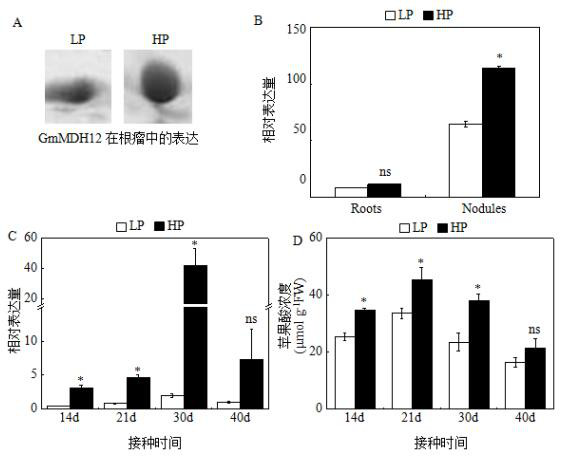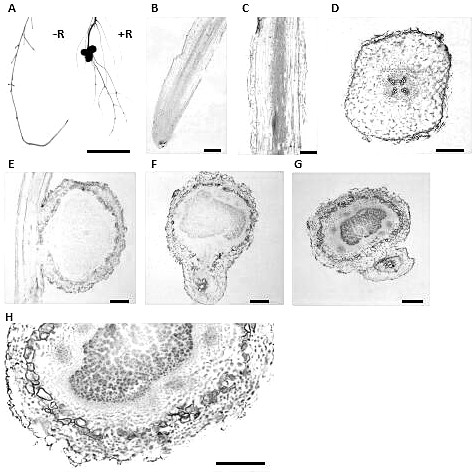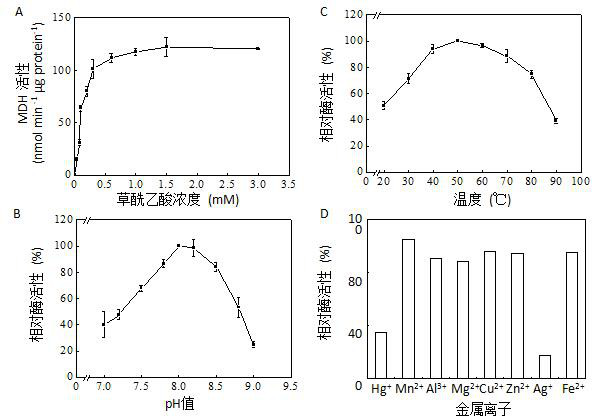Application of gmmdh12 Gene in Promoting Soybean Nodulation and Nitrogen Fixation
A technology of soybean root nodule and gene, which is applied in the fields of application, genetic engineering, plant genetic improvement, etc.
- Summary
- Abstract
- Description
- Claims
- Application Information
AI Technical Summary
Problems solved by technology
Method used
Image
Examples
Embodiment 1
[0045] Example 1 GmMDH12 Gene cloning and expression analysis
[0046] 1. GmMDH12 protein expression analysis
[0047] Experimental design of root nodule proteomics analysis: 5 days after seed germination of soybean variety "HN66", the seedlings were inoculated with Rhizobium BXYD3 for 1 hour, and then transferred to low phosphorus (LP, 5 μM KH 2 PO 4 ) or high phosphorus (HP, 250 μM KH 2 PO 4 ) low nitrogen nutrient solution (50 μM NH 4 NO 3 ), after 25 days of culture, the shoots, roots and nodule samples were harvested and stored at -80 ℃ for the extraction of nodulin and RNA. Experimental design of gene expression analysis at different time points: 5 days after the germination of soybean HN66 seeds, the seedlings were inoculated with Rhizobium BXYD3 for 1 hour, and then transferred to low phosphorus (LP, 25 μM KH 2 PO 4 ) or high phosphorus (HP, 500 μMKH 2 PO 4 ) low nitrogen nutrient solution (250 μM NH 4 NO 3 ) in culture, on the 14th, 21st, 30th and 40th day...
Embodiment 2
[0058] Example 2GmMDH12 Gene promoter cloning, vector construction and tissue localization analysis
[0059] 1. Experimental method
[0060] GmMDH12 Gene promoter cloning and GUS expression vector construction: extract soybean root genomic DNA, use soybean genomic DNA as a template, use upstream specific primer 5'-GGGATCCCCGTGCATGTGTTGA-3' (SEQ ID NO:9) and downstream specific primer 5'-ATGAATTCAGTGGCGATTAGTGAG- 3' (SEQ ID NO:10) amplification GmMDH12 Promoter 2182bp (SEQ ID NO:11), after PCR fragment recovery and sequencing, passed Bam H I and EcoR I carried out double enzyme digestion to the recovered fragment and the target vector pCAMBIA1391, connected the promoter fragment to pCAMBIA1391, and then transformed the constructed GUS expression vector into Agrobacterium rhizogenes K599 by the freeze-thaw method (the K599 bacterial strain was obtained from Queensland, Australia Donated by the Leguminous Comprehensive Research Center of the University, it is preserved in t...
Embodiment 3
[0065] Example 3 GmMDH12 enzymatic property analysis
[0066] 1. Experimental method
[0067] (1) Construction of prokaryotic expression vector: using soybean root nodule cDNA as template, using upstream specific primer 5'-GGATCCATGATGAAGCCATCGA-3' (SEQ ID NO:12) and downstream specific primer 5'-ACATGAATTCTTACTGGTTGGCAAATT-3' (SEQ ID NO: 13) Amplification GmMDH12 The full length of the gene, after the PCR fragments were recovered and sequenced correctly, passed Bam H I and EcoR After carrying out double digestion of the fragment and the prokaryotic expression vector pGEX6P-3 (GE-Healthcare, USA), the GmMDH12 The gene was connected to the target vector pGEX6P-3, and then the constructed expression vector was transformed into BL21 Escherichia coli by freeze-thaw method.
[0068] (2) Take an appropriate amount of the BL21 bacterial solution containing the target gene and culture it in 200 mL of fresh LB liquid medium at 28°C until the OD600 is 0.4, then add 0.2 mM IPTG t...
PUM
 Login to View More
Login to View More Abstract
Description
Claims
Application Information
 Login to View More
Login to View More - R&D
- Intellectual Property
- Life Sciences
- Materials
- Tech Scout
- Unparalleled Data Quality
- Higher Quality Content
- 60% Fewer Hallucinations
Browse by: Latest US Patents, China's latest patents, Technical Efficacy Thesaurus, Application Domain, Technology Topic, Popular Technical Reports.
© 2025 PatSnap. All rights reserved.Legal|Privacy policy|Modern Slavery Act Transparency Statement|Sitemap|About US| Contact US: help@patsnap.com



